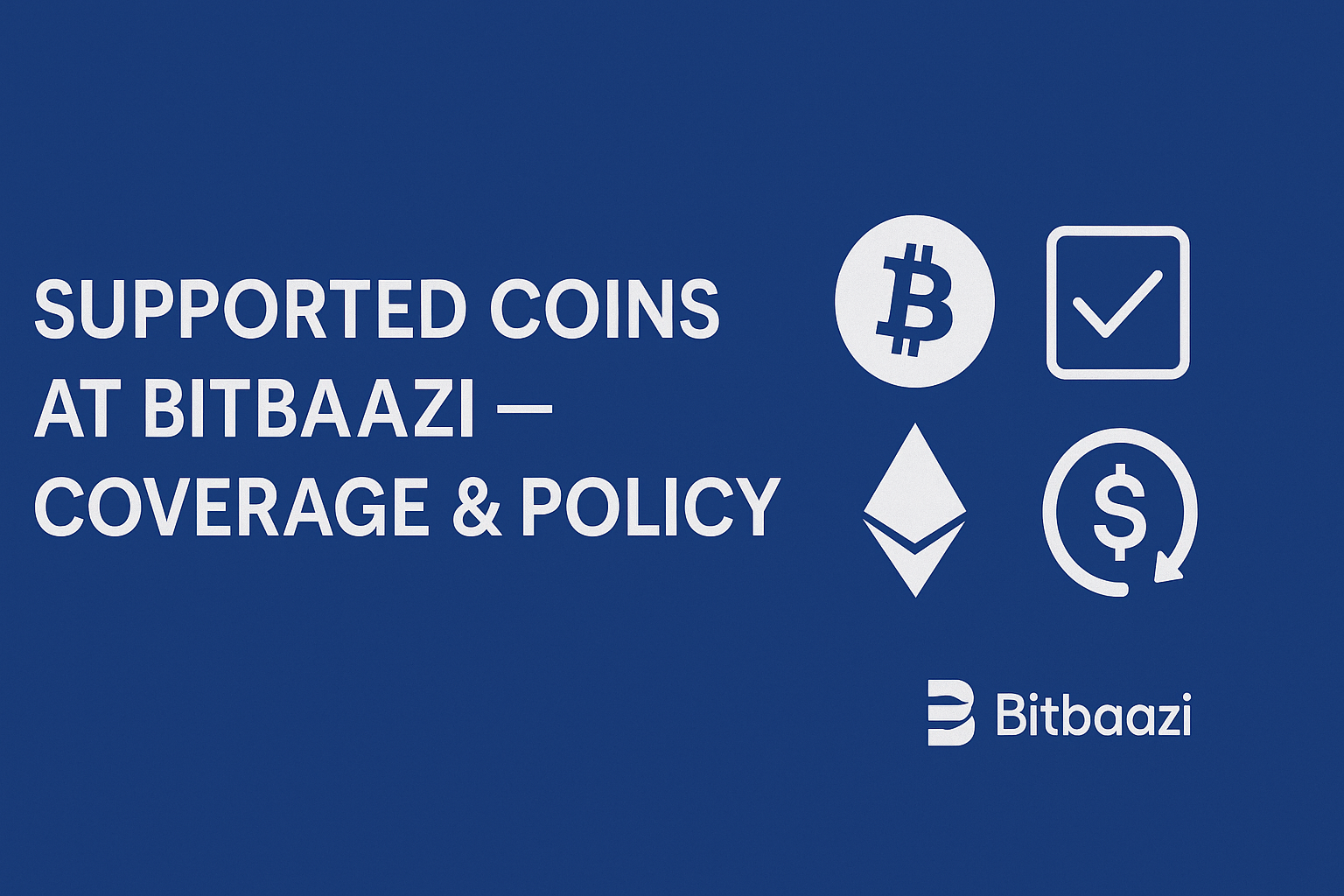Summary
- What “supported” means across assets and networks.
- How we verify tickers, addresses, and contracts.
- When coverage is paused, reviewed, or delisted.
- Where to find fees, memos/tags, and network notes.
Bitbaazi maintains an independent catalog of crypto assets. Our Supported Coins policy explains what we cover, how we verify on-chain details, and when we pause or delist. It’s designed for clarity across tickers, networks, and contract addresses.
Coverage scope & definitions
We define coverage at the asset level, then map to networks and contract forms.
We classify base assets (e.g., BTC, ETH) separately from token contracts on smart-contract chains. On contract platforms, we track ERC-20 on Ethereum, TRC-20 on TRON, and SPL tokens on Solana as distinct per-chain assets with issuer-confirmed identifiers.
Coverage is not the same as custody or listing on an exchange. It means Bitbaazi’s pages resolve the correct ticker, chain, memo/tag needs, and canonical contract or address for the asset on each supported network.
Identifiers we verify
To avoid confusion, we confirm multiple identifiers before adding coverage.
Ticker collisions happen across chains and markets. We scope each ticker by chain and contract (e.g., per-chain “USDT”), and we link directly to issuer or standards documentation where applicable.
Addresses & contracts. For Ethereum-style addresses we display (or validate against) EIP-55 checksums and may warn on non-checksummed input; some implementations extend this with chain-id aware checksums (EIP-1191) to reduce cross-network mistakes.
Bitcoin formats. We recognize legacy, P2SH, and Bech32 (native SegWit) address families and document when a receiver requires a specific format. Our pages prefer standard Bech32 per BIP-173 where supported.
Listing, review & delisting
We can add, hold, or remove coverage based on objective operational triggers.
Listing. We add an asset page when the canonical address/contract is public and stable, the issuer documentation is available, and the network is widely recognized. For stablecoins, we rely on official contract directories (e.g., USDC contract addresses) and issuer transparency pages (e.g., Tether).
Review. We run periodic checks and also respond to material issuer updates (e.g., chain migrations such as native deployments announced by the issuer like USDC on Base on 2023-09-05).
Delisting or pause. We may pause or mark pages “inactive” when contracts migrate without authoritative notice, tickers collide irreconcilably, or a chain halts for extended periods. Historical pages remain for reference with a timestamped notice.
FAQ
- Do you separate USDT on TRON vs Ethereum? Yes—pages scope “USDT-TRC20” and “USDT-ERC20” with issuer links (Tether Transparency, updated daily).
- When are pages refreshed? We batch weekly, and on major issuer posts—e.g., Circle’s “USDC on Base” on 2023-09-05.
- Do you show checksummed ETH addresses? Yes—EIP-55 checksums are preferred; chain-id aware variants follow EIP-1191.
- Where do stablecoin contracts come from? From issuer directories (e.g., Circle’s USDC contract addresses) and legal/terms pages.
Takeaways
- Treat tickers as chain-scoped; always confirm the contract/address on the right network.
- Prefer checksummed inputs and documented address formats (EIP-55, BIP-173).
- Follow issuer announcements for contract migrations and native deployments.
- Bitbaazi coverage is informational; it is not investment advice or a listing endorsement.
【ZH(简体)】
覆盖范围与定义
我们先定义资产,再映射到网络与合约形态。
基础资产(如 BTC、ETH)与合约型代币分开记录;在合约平台上,我们将以太坊的 ERC-20、波场的 TRC-20 与 Solana 的 SPL 视为按链区分的独立资产,并以发行方确认的标识为准。文中只在此处自然出现一次“Supported Coins”。
覆盖并不等同于交易所上架或托管,它表示页面会给出正确的代码、链别、Memo/Tag 要求以及每条网络的权威合约或地址。
我们核验的标识符
为避免混淆,我们在收录前会交叉核验多个标识符。
代码(Ticker) 可能跨链重名,我们会以链与合约为作用域(如将“USDT”按链区分),并优先链接至发行方或标准文档。
地址与合约。 以太坊地址优先使用 EIP-55 校验和格式,必要时提示非校验和输入;部分实现会采用带链 ID 的 EIP-1191。比特币地址方面,我们识别 legacy、P2SH 与 Bech32(BIP-173)并在页面提示接收方要求。
上架、复核与下线
我们基于可验证的运营信号新增、保留或下线页面。
新增。 当权威地址/合约稳定、发行方文档完备、网络被广泛采用时收录。稳定币以官方合约目录(如 USDC)与透明度页面(如 Tether)为准。
复核。 定期批量检查,并在重要公告(如原生部署或迁移)发布时即时更新。下线或暂停。 若出现未公告的合约迁移、严重重名冲突或链长时间停止出块,将暂停并保留带时间戳的历史页。
【JA 】
カバレッジ範囲と定義
資産を起点に各ネットワークと契約形態へマッピングします。
基軸資産(BTC・ETH)とトークン契約を区別し、Ethereum の ERC-20、TRON の TRC-20、Solana の SPL はチェーンごとに別資産として扱います。発行体が確認する識別子を基準にし、本稿では “Supported Coins” を1度だけ自然に記載します。
カバレッジは取扱い・上場の推奨ではなく、正しいティッカー、対応チェーン、メモ/タグ、各ネットワークの正規契約/アドレスを示すことを意味します。
確認する識別子
混同を避けるため、複数の識別子を照合してから収録します。
ティッカー。 重複は起こり得るためチェーンと契約単位で管理します(例:USDT はチェーン別)。アドレス/契約。 ETH 系は EIP-55 のチェックサム表記を優先し、一部は EIP-1191 のチェーン ID 連動型も扱います。Bitcoin は legacy/P2SH/Bech32(BIP-173)を識別します。
上場・見直し・上場廃止
客観的な運用シグナルに基づき追加・保留・停止を判断します。
追加。 正規アドレス/契約が公開・安定し、発行体ドキュメントが整い、広く利用されるネットワークであること。安定通貨は公式の契約一覧や透明性ページを参照します。見直し。 定期チェックと重大アナウンス時の即時更新。停止。 無通告の契約移行や深刻な重複、長期停止などは一時停止し、履歴ページに日時を残します。
